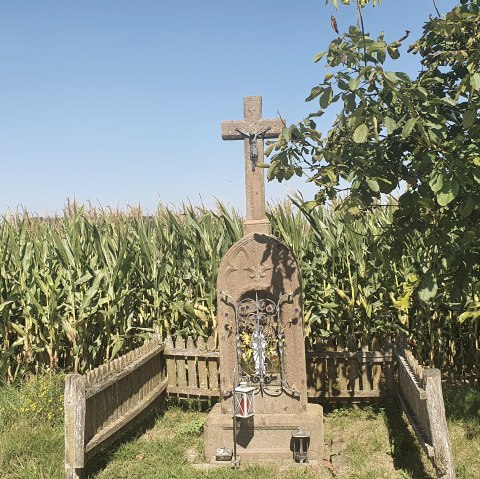Eifelverein - Willibrordusweg 5. Etappe
Oberweis
This main hiking trail (HWW) of the Eifelverein commemorates the missionary activities of St. Willibrordus, the founder of the monastery in Echternach, and the pilgrimages to venerate him.
From Prüm, the hiking trail leads into the Nimstal valley, continues into the Prüm valley, descends past the Bitburg reservoir and reaches Echternacherbrück in the Sauer valley via bizarre rock formations on the edge of the Ferschweiler plateau. On the other side of the bridge is Echternach with its basilica and the tomb of St. Willibrord.
Route: Oberweis - Altbettingen - Wolsfelderberg - Hubertuskreuz - spider with refuge - Prümerburg vacation village - Prümerburg castle ruins (14.5 km)
Route description:
Take the AE-Weg Oberweis in a southerly direction. Leave Oberweis on the >Kuhweg< road in a southerly direction, along the camping facilities, gradually leaving the Prümtal valley, to the hamlet of Altbettingen (1.6 km) [1]. Through forest and across open countryside, cross the K 14 (5.7 km) and along forest edges over the heights between Prüm and Nims to the village of Wolsfelderberg (9.1 km) with the Marienkapelle chapel [2]. Through the forest, first past the Hubertus cross [3] and later past a refuge, then right at a spur with a refuge (11.3 km). After approx. 200 m turn left, here the Felsenweg 5 >Prümerburg< meets, with it on hillside paths to the Prümerburg vacation village (13.9 km). Where the Felsenweg leads into the vacation village, continue half right to the KD Ruine Prümerburg (14.5 km) [4].
[1] Three Roman. Manor districts were located in the district of Altbettingen. This place was abandoned by its inhabitants after the plague in the 17th century. Approx. 250 m before the current settlement, a path leads to the castle ruins, which may not be entered due to the risk of collapse. The castle was built in the 13th century by the Lords of Falkenstein.
[2] The Marienkapelle chapel was built from a modest residential building in the 19th century, which was no longer used after the Second World War. According to the plans of a professor born in Wolsfeld, a day laborer's house was converted into a chapel and meeting place and consecrated in 1986.
[3] St. Hubert's Cross, made of red sandstone, dated 1691. The relief shows St. Hubert praying in front of a stag with a crucifix in its antlers.
[4] KD Ruin >Prümerburg<, the castle, first mentioned in 1337, lies on a protruding, steeply sloping sandstone rock. The castle burned down in 1658, but parts of the pentagonal pallas and a cellar have been preserved after renovation and securing work.
Marking of our main hiking trails: Three-colored "E" (blue: for sky and water; brown: for earth and soil; green for meadows and forests) on a white mirror; above it "EIFELVEREIN", below it the name of the trail on a green field.
Marking of the tour:






